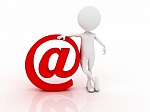 Email marketing—a popular form of marketing directly to the customer/subscriber—has the appeal (and appearance) of being free. Well, it’s not free…but the cost is low, and when done correctly, the Return-on-Investment (ROI) can be remarkable.
Email marketing—a popular form of marketing directly to the customer/subscriber—has the appeal (and appearance) of being free. Well, it’s not free…but the cost is low, and when done correctly, the Return-on-Investment (ROI) can be remarkable.
 Email marketing—a popular form of marketing directly to the customer/subscriber—has the appeal (and appearance) of being free. Well, it’s not free…but the cost is low, and when done correctly, the Return-on-Investment (ROI) can be remarkable.
Email marketing—a popular form of marketing directly to the customer/subscriber—has the appeal (and appearance) of being free. Well, it’s not free…but the cost is low, and when done correctly, the Return-on-Investment (ROI) can be remarkable.
In addition to a good email software or service bureau, your investment includes the time required to maintain the process, create timely and meaningful messages, and to sustain an effective relationship with a targeted audience.
But it’s not as simple as it looks…
The apparent simplicity of email disguises the painful fact that it’s easy to get it wrong. Without proper guidance, your well-intended email marketing effort can produce unhappy customers, broken relationships, and zero new business.
Fortunately, some of the top professionals in the email industry compiled a great guidebook titled, 221 Email Marketing Do’s and Don’ts: Best Practices Reference Guide by the Email Experience Council (EEC) and business software company Listrak. The EEC is the email-marketing arm of the Direct Marketing Association (DMA), a worldwide professional organization.
You’ll want to review the entire list of 221 rules of the road, but—with a tip of the hat to the EEC and DMA industry folks, here’s our pick of 20 “do’s” that can kick-start a successful, opt-in email marketing effort:
- Build your own list and collect data at every customer touch-point, both online and offline.
- Keep the opt-in process quick and simple—only collect the profiling attributes that are most important to your business.
- Allow visitors to opt-in to your email list from every page of your website, not just the home page.
- Focus on the quality of our subscribers, not the quantity.
- De-dupe (remove duplicate entries) in your list to ensure subscribers only receive one copy of your email messages.
- Keep message design simple, clean and easy to read.
- Write a clear call-to-action and keep the offer visible above the fold.
- Don’t distract the recipient from completing a call-to-action by including too many offers, graphics, etc.
- Include your company name in the FROM address of your messages so recipients know that the message was sent from a legitimate sender.
- Keep your brand identity in front of your audience with regular emails that are relevant to their needs.
- Remember that your brand is more than just a logo and corporate look—it’s also your corporate voice and personality.
- Segment your list by many different attributes, not just one, as you’ll be targeting smaller groups with information that is even more specific to their needs.
- Remember that relevant messages do not rely on a sending schedule—you can send emails more often as long as each message contains information that is important to each subscriber.
- Keep emails short and to the point.
- Remember that any unwanted messaged is considered spam, even if the recipient opted-in to the list; sending only relevant emails will protect your reputation.
- Include a way for subscribers to opt-in to your list again in case they unsubscribed accidently or changed their minds.
- Remove “unsubscribers” from your list within 10 days; or better yet, immediately.
- Write compelling subject lines.
- Use your email marketing to enhance your direct mail campaigns and social networking channels.
- Ensure that you have the proper resources in place to handle the additional traffic, calls, etc. that emails generate.








